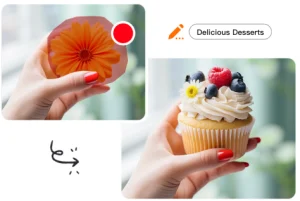Magic and mayhem of free ai replace tool If you have ever tried using a free ai replace tool, you know its potential. A single click then your background image disappears. Through the tap of a few fingers, text changes with the contortions of silly putty. The 64 thousand dollar question is however, whether one may trust AI to get the small details right, or whether a good pair of human eyes can still take the trophy home. Also, what is the best method of preventing your writing to have the appearance of an uncomfortably shiny-eyed android doing all the work?

The reason behind AI replacement tools existence, and who should use them
Online content is the meat and potatoes of any on-line venture. Time is relevant whether you are a courageous entrepreneur developing an Etsy store or simply wish to make your old family photos interesting. The tools of replacement with the help of AI became very popular due to their rapidity and availability. Why hire a pro when you can swipe, tap or drag and at no cost?
Consider Pixlr, Remini, SnapEdit or cleanup.pictures. On these platforms, however, new users can do what once used to be treated like family secrets passed down in generations – take the items out, change faces, even blurry selfies with a little help. It is the new normal for freelancers operating on a shoestring budget, creators who are still in a dorm room, or to anyone who is sick of hulking photo editors.
However, and there is quite a but, can you trust on free tools by themselves? Okay, let us bring it down.
Instant Results and The Uncanny Valley
Deep learning is the bet of most free platforms. Take an untidy shot, upload and be gone in seconds: those unpleasant neighbors are erased off your beach shot. No sweat Photoshop. AI is able to identify edges as well as fill the gaps in less time than it takes to say abracadabra.
It is not perfectly image based all the time. There are also cases when those magic pixels may create some strange shadows, or leave some ghost animals behind. Who are the most popular culprits? Hair, skin, a busy backgrounds these are areas of problems that are hard nuts to crack in automation. Fact: The paper by Akhger et al. (2023) studies in Visual Computing results suggest that up to 38 percent, human editors will perform tricky removal tasks better than algorithms.
Does it imply that beginners should not use AI? Not even anywhere close. This implies that you must be aware of where it glows and when you are supposed to drive the steering wheel.
Manual Editing vs. AI Editing: The Face of Contender
We can preset a simple set up. You have a portrait where soda can sits smack in the middle. You post on a free AI replace site, and turn the robot loose.
The Artificial Intelligence strategy:
Blitz object remover.
Bodies at plain backgrounds.
Textural battles (with swishing hair or foliage trees).
May distort the location that the soda can inhabited.
Thus, step by step:
It takes a longer time to respond particularly to novices.
It takes a steady hand, a careful patience and a mouse.
Fine-tuned control. The deceptive edges are more natural.
Is able to improvise instead of guessing lost textures.
Real life outcomes? AI is ridiculously good at high-contrast usually smooth backgrounds. Manual is unrivaled when it comes to cluttered detailed images. Here is a tip: use the combination of both. Trust the computer and AI, and correct the details by hand.
The Advice on Utilizing Free AI Replacement Tools and Not Wasting Quality

-
The Right Tool to Your Goal
Not every AI tool is the same. Some have been constructed to remove faces and others are master at logging off logos or power lines. Run a speed test of your preferred two to three candidates. You can use forums, or Google to identify what the hot pictures are at the moment, and more communities provide genuine, non-edited reviews, such as the r/photography at reddit.
-
Post High Originals
Unless what you give it, AI will fail to work. Begin with sharp clear photographs. The cleaner your initial point the less strange smears of paint or ghosting you will see.
-
Zoom, Inspect, and Fix
Once AI gets the task done, never forget to look closely at the outcome. Zoon, particularly at edges or sign changes in color. Impediments that are weak can shine through on the social media or the print. There are tools that are free such as GIMP or Paint.NET and these are great tools that allow one to correct minor AI errors easily.
-
Don’t Over-Process
AI is over-delivering, it is tempting, as glitter glue at the age of nine. And when it comes to the little enjoyment, A big dose is a mess. It is best to limit yourself to one to two edits per photo. Low quality may be introduced through multiple passes leaving visible brush marks.
-
Save Your Progress
Layers work, when you can use it. Save every key step. In such a way, in the event that AI smears Aunt Linda or takes away a half a dog out of the photo, you can simply take a step back and retouch only your mistakes.
So who is the Speed to Comparison? AI Replaces What?
AI takes gold in terms of raw speed. Manual editing is comparable with knitting a scarf a fulfilling process, but it is so time consuming. The AI would be more of a microwave meal. The fact check: Additional artificial intelligence-based applications such as SnapEdit and Retoucher may take less than 10 secs to process a complex image whereas even the professional using Photoshop might require up to 5-10 mins to fix the issue.

But with manual you can make creative decision. Perhaps you must keep something and leave a shadow, or you wish to mix in something in the background; AI does not raise questions. It simply does.
Will the Difference be Sensed or Felt by People?
In content that has to be fast paced like Instagram Stories, jokes, memes, AI can typically suffice. When you have a wedding album, a family Christmas card or professional portfolio to prepare, give yourself time to proofread (and proofcorrect everything that the robot did not). Even a keen-eyed friend may notice AI fingerprints, particularly in textures of the skin or on top of each other.
